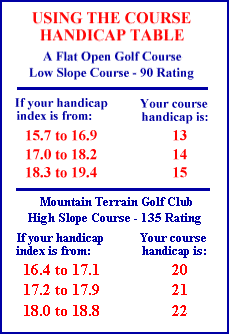|
Slope: How it Works What is the Slope System? Courses have been re-rated according to their relative difficulty for all levels of golfers, not just the experts. The Slope System adjusts a golfer's handicap to the course that is being played. That's why it's called Slope - because when you post the scores on a graph (see diagram), the line climbs on a slope. The Slope of a more difficult course is steeper than an easier course, meaning that high handicappers pick up more strokes than better players.
 Under Slope, golfers will no longer have a handicap. Instead, you will have an index, a number expressed in a decimal (13.4, 5.2, 29.3, etc.). Your index is a mathematical calculation of your playing ability on an average golf course (i.e., a course with a 113 Slope rating). The maximum index allowed is 36.4 for men and 40.4 for women. For men with the maximum index, the course handicap could exceed 48 on a high Slope course. What is the Course Handicap? Before you can determine what your course handicap is for any given round, you must know:
This means that all of North America and several other countries around the world will be on the Slope system. Courses will have been rated for not just the expert but for all abilities, and each course will have been rated on it's own degree of difficulty. By changing to the Slope system you will be able to compete against each other, no matter what course you are on, with more equity. What do I need to know? What if I play a course without a Slope rating? What if someone without an index comes to my course? How do I adjust and use Equitable Stroke Control (ESC)? Use your course handicap. If it is ......
1 to 18 inclusive.......Limit of two over par. 19 to 32 inclusive.....Limit of three over par. 33 or over................Limit of four over par. When you return to your home course, record the score. At that time you must record the course and the Slope ratings of the "away" course, as well as your score. What happens when I play in a tournament? How can I check my handicap Index to make sure it is accurate?
|
